Swollen lymph nodes
Lymph nodes are present throughout your body. They are an important part of your immune system. Lymph nodes help your body recognize and fight germs, infections, and other foreign substances.
The term "swollen glands" refers to enlargement of one or more lymph nodes. The medical name for swollen lymph nodes is lymphadenopathy.
In a child, a lymph node is considered enlarged if it is more than 1 centimeter (0.4 inch) wide.
Considerations
Lymph nodes - Animation
The lymphatic system has two main functions. Its network of vessels, valves, ducts, nodes, and organs helps balance the body's fluid by draining excess fluid, known as lymph, from the body's tissue and returning it to the blood after filtering it. Some types of blood cells are also made in the lymph nodes. The lymphatic system also plays an important role in the body's immune system. Infection, even a trivial infection is, the most common cause of swollen lymph nodes. Let's look at a cut section of a lymph node to see what happens. Afferent means towards. Afferent lymph vessels bring unfiltered fluids from the body into the lymph node where they are filtered. Efferent vessels, meaning away from, carry the clean fluid away and back to the bloodstream where it helps form plasma. When the body is invaded by foreign organisms, the swelling sometimes felt in the neck, armpits, groin, or tonsils comes from the microorganisms trapped inside the lymph nodes. Eventually, these organisms are destroyed and eliminated by cells that line the node walls. Then the swelling and pain subside.
Common areas where the lymph nodes can be felt (with the fingers) include:
- Groin
- Armpit
- Neck (there is a chain of lymph nodes on either side of the front of the neck, both sides of the neck, and down each side of the back of the neck)
- Under the jaw and chin
- Behind the ears
- On the back of the head
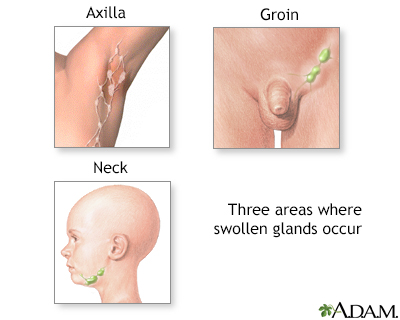
Swollen glands
Lymph nodes play an important part in the body's defense against infection. Swelling might occur even if the infection is trivial or not apparent. Swelling of lymph nodes generally results from localized or systemic infection, abscess formation, or malignancy.
Causes
Infections are the most common cause of swollen lymph nodes. Infections that can cause them include:
- Abscessed or impacted tooth
Abscessed
A tooth abscess is a pocket of pus caused by a bacterial infection.
 ImageRead Article Now Book Mark Article
ImageRead Article Now Book Mark ArticleImpacted tooth
An impacted tooth is a tooth that does not break through the gum.
Read Article Now Book Mark Article - Ear infection
Ear infection
Otitis is a term for infection or inflammation of the ear.
 ImageRead Article Now Book Mark Article
ImageRead Article Now Book Mark Article - Colds, flu, and other infections
Colds
The common cold most often causes a runny nose, nasal congestion, and sneezing. You may also have a sore throat, cough, headache, or other symptoms....
 ImageRead Article Now Book Mark Article
ImageRead Article Now Book Mark ArticleFlu
The flu (influenza) is a viral respiratory illness that causes fever, chills, runny nose, body aches, and cough. It spreads easily from person to pe...
 ImageRead Article Now Book Mark Article
ImageRead Article Now Book Mark Article - Swelling (inflammation) of gums (gingivitis)
- Mononucleosis
Mononucleosis
Mononucleosis, or mono, is a viral infection that causes fever, sore throat, and swollen lymph glands, most often in the neck.
 ImageRead Article Now Book Mark Article
ImageRead Article Now Book Mark Article - Mouth sores
Mouth sores
There are different types of mouth sores. They can occur anywhere in the mouth including bottom of the mouth, inner cheeks, gums, lips, and tongue....
 ImageRead Article Now Book Mark Article
ImageRead Article Now Book Mark Article - Sexually transmitted illness (STI)
- Tonsillitis
Tonsillitis
Tonsillitis is inflammation (swelling) of the tonsils.
 ImageRead Article Now Book Mark Article
ImageRead Article Now Book Mark Article - Tuberculosis
Tuberculosis
Pulmonary tuberculosis (TB) is a contagious bacterial infection that involves the lungs. It may spread to other organs.
 ImageRead Article Now Book Mark Article
ImageRead Article Now Book Mark Article - Skin infections
Skin infections
Cellulitis is a common skin infection caused by bacteria. It affects the middle layer of the skin (dermis) and the tissues below. Sometimes, muscle...
 ImageRead Article Now Book Mark Article
ImageRead Article Now Book Mark Article
Immune or autoimmune disorders that can cause swollen lymph nodes are:
- HIV
HIV
Human immunodeficiency virus (HIV) is the virus that causes acquired immunodeficiency syndrome (AIDS). When a person becomes infected with HIV, the ...
 ImageRead Article Now Book Mark Article
ImageRead Article Now Book Mark Article - Rheumatoid arthritis (RA)
Rheumatoid arthritis
Rheumatoid arthritis (RA) is a disease that leads to inflammation of the joints and surrounding tissues. It is a long-term disease. It can also aff...
 ImageRead Article Now Book Mark Article
ImageRead Article Now Book Mark Article
Cancers that can cause swollen lymph nodes include:
- Leukemia
Leukemia
Leukemia is a type of blood cancer that begins in the bone marrow. Bone marrow is the soft tissue in the center of the bones, where blood cells are ...
 ImageRead Article Now Book Mark Article
ImageRead Article Now Book Mark Article - Hodgkin disease
Hodgkin disease
Hodgkin lymphoma is a cancer of lymph tissue. Lymph tissue is found in the lymph nodes, spleen, liver, bone marrow, and other sites.
 ImageRead Article Now Book Mark Article
ImageRead Article Now Book Mark Article - Non-Hodgkin lymphoma
Non-Hodgkin lymphoma
Non-Hodgkin lymphoma (NHL) is cancer of the lymph tissue. Lymph tissue is found in the lymph nodes, spleen, and other organs of the immune system. W...
 ImageRead Article Now Book Mark Article
ImageRead Article Now Book Mark Article
Many other cancers may also cause swollen lymph nodes.
Certain medicines can cause swollen lymph nodes, including:
- Seizure medicines, such as phenytoin
- Typhoid immunization
Immunization
Vaccines are used to boost your immune system, reduce the risk of infection, and lessen the severity of infections, including those that cause seriou...
 ImageRead Article Now Book Mark Article
ImageRead Article Now Book Mark Article
Which lymph nodes are swollen depends on the cause and the body parts involved. Swollen lymph nodes that appear suddenly and are painful are usually due to injury or infection. Slow, painless swelling may be due to cancer or a tumor.
Home Care
Painful lymph nodes are generally a sign that your body is fighting an infection. The soreness usually goes away in a couple of days without treatment. The lymph node may not return to its normal size for several weeks.
When to Contact a Medical Professional
Contact your health care provider if:
- Your lymph nodes do not get smaller after several weeks or they continue to get larger.
- They are red and tender.
- They feel hard, irregular, or fixed in place.
- You have fever, night sweats, or unexplained weight loss.
- Any node in a child is larger than 1 centimeter (0.4 inch) in diameter.
What to Expect at Your Office Visit
Your provider will perform a physical examination and ask about your medical history and symptoms. Examples of questions that may be asked include:
- When the swelling began
- If the swelling came on suddenly
- Whether any lymph nodes are painful when pressed
The following tests may be done:
- Blood tests, including liver function tests, kidney function tests, and CBC with differential
Liver function tests
Liver function tests are common tests that are used to see how well the liver is working. Tests include:AlbuminAlpha-1 antitrypsinAlkaline phosphata...
 ImageRead Article Now Book Mark Article
ImageRead Article Now Book Mark ArticleKidney function tests
Kidney function tests are common lab tests used to evaluate how well the kidneys are working. Such tests include:BUN (Blood urea nitrogen) Creatinin...
 ImageRead Article Now Book Mark Article
ImageRead Article Now Book Mark ArticleCBC
A complete blood count (CBC) test measures the following:The number of white blood cells (WBC count)The number of red blood cells (RBC count)The numb...
 ImageRead Article Now Book Mark Article
ImageRead Article Now Book Mark ArticleDifferential
The blood differential test measures the percentage of each type of white blood cell (WBC) that you have in your blood. It also reveals if there are...
 ImageRead Article Now Book Mark Article
ImageRead Article Now Book Mark Article - Lymph node biopsy
Biopsy
A biopsy is the removal of a small piece of tissue for lab examination.
 ImageRead Article Now Book Mark Article
ImageRead Article Now Book Mark Article - Chest x-ray
Chest x-ray
A chest x-ray is an x-ray of the chest, lungs, heart, large arteries, ribs, and diaphragm.
 ImageRead Article Now Book Mark Article
ImageRead Article Now Book Mark Article - CT scan of the abdomen
Treatment depends on the cause of the swollen nodes.
Reviewed By
Linda J. Vorvick, MD, Clinical Professor, Department of Family Medicine, UW Medicine, School of Medicine, University of Washington, Seattle, WA. Also reviewed by David C. Dugdale, MD, Medical Director, Brenda Conaway, Editorial Director, and the A.D.A.M. Editorial team.
Tower RL, Camitta BM. Lymphadenopathy. In: Kliegman RM, St. Geme JW, Blum NJ, Shah SS, Tasker RC, Wilson KM, eds. Nelson Textbook of Pediatrics. 21st ed. Philadelphia, PA: Elsevier; 2020:chap 517.
Winter JN. Approach to the patient with lymphadenopathy or splenomegaly. In: Goldman L, Cooney KA, eds. Goldman-Cecil Medicine. 27th ed. Philadelphia, PA: Elsevier; 2024:chap 154.


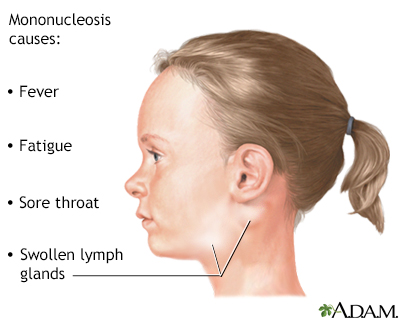
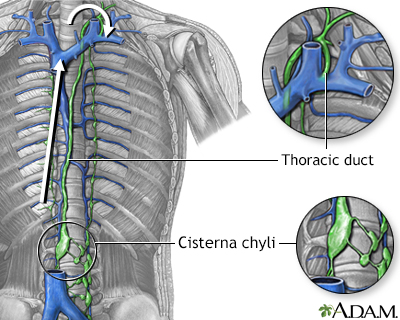
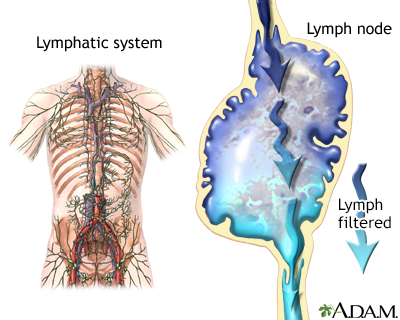
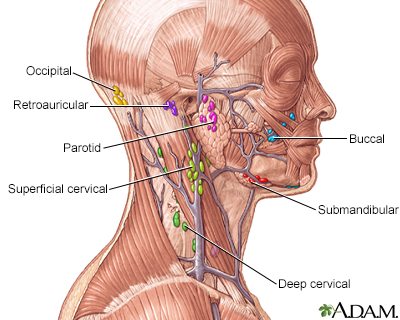
 All rights reserved.
All rights reserved.